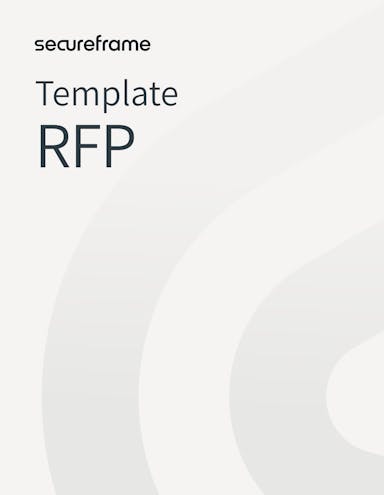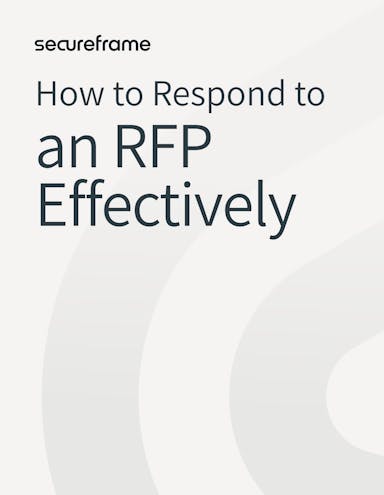
What is the RFP Process? A 5-Step Guide + Checklist
Emily Bonnie
Senior Content Marketing Manager
Anna Fitzgerald
Senior Content Marketing Manager
Requests for Proposals (RFPs) help organizations make informed, transparent, and strategic decisions when selecting vendors, ultimately leading to better project outcomes, cost savings, and stronger vendor relationships.
A good RFP process is clear, collaborative, and organized. We’ve broken the RFP process down into five steps to ensure that you attract the best vendors as well as manage the entire process efficiently and effectively, and we’ve provided a simple checklist you can use as a guide.
What is a Request for Proposal (RFP)?
An RFP, or Request for Proposal, is a formal document issued by an organization to solicit proposals from potential suppliers, contractors, or service providers. It’s part of a formal selection process that helps organizations learn about multiple service providers and select the one that best meets their needs. Many organizations and government agencies use RFPs as part of the vendor procurement process.

RFx: Types of vendor assessments
Vendor assessments are an essential step for businesses in evaluating and selecting the right service providers. Several types of vendor assessments are available to evaluate different aspects of a vendor's capabilities and suitability.
- Request for Proposal (RFP): Used when an organization needs to buy a product or service and wants to invite various bidders to propose what they can offer. Allows the company to compare options and select the best fit based on their organization’s needs and budget.
- Request for Information (RFI): Used when an organization wants to understand what options are available in the market. Gathers general information from prospective vendors or suppliers about their products, services, or capabilities.
- Request for Quotation (RFQ): Used when an organization already knows the specific product or service it needs and is seeking detailed pricing information from potential suppliers.
- Due Diligence Questionnaire (DDQ): Used to evaluate a potential vendor’s financial health, business practices, security posture, regulatory compliance, and other risk factors.
- Security Questionnaire: Used to assess a third-party vendor’s data protection practices, including access controls, network security, compliance with relevant regulations, and incident response capabilities.
Recommended reading

What is a Request for Proposal? + Template
5 steps of an effective RFP process
An effective RFP process can both streamline the vendor procurement process and ensure you find the best service provider for your needs. Below, we’ve broken the process down into five steps, shared some tips and best practices, and provided a simple checklist to follow.
Step 1: Define the project plan and scope
This is arguably the most important step in the RFP process. Clarity and alignment around your organization’s needs and project goals are essential for drafting complete and effective RFP requirements.
Start by clearly identifying the primary objectives of the project. Consult with stakeholders across the organization to understand requirements from different perspectives. What are the key outcomes you expect to achieve? How will you measure success? This helps align the project scope with your organization's top-level goals.
With a clear sense of what you’re hoping to achieve, you can outline specific requirements. This might include software specifications, hardware needs, system integrations, data requirements, and compliance requirements. Provide a realistic budget and timeline for the project, including key milestones, deadlines, and dependencies. This helps vendors assess their ability to meet your timeline and stay within budget.
During this stage, it’s also important to identify potential third-party risks and consider how these risks should be managed. What data security standards will you require? Identify any compliance or regulatory requirements that the project must adhere to, and be sure to involve information security, compliance, or IT team members in this part of the process.
Next, draft the scope of work. This will be included in the RFP document and should detail what the project will include and what it won’t (referred to as "in-scope" and "out-of-scope" activities). Be specific about the deliverables, tasks, services, or products required. It’s just as important to be upfront about what won’t be included in scope — specify any limitations, constraints, or exclusions that vendors should be aware of.
Step 2: Write the RFP document
What constitutes a good RFP? An effective RFP should outline the specifics of the project and the organization's requirements:
- Overview and Introduction: This portion offers an overview of the organization issuing the RFP and its objectives. It typically comprises the company's name and contextual details regarding the project or need the RFP seeks to address.
- Project Description and Work Scope: In this section, the issuer elaborates on the specific project they are soliciting proposals for. It covers the project goals, expected deliverables, and the scope of work. It might also include the anticipated duration of the project, any significant milestones, limitations, or necessary prerequisites.
- Specifications and Requirements: This segment lays out the technical, functional, and performance criteria of the product or service. It often contains comprehensive descriptions of the tasks, desired attributes, and the standards that need to be met.
- Guidelines for Proposal Submission: Here, instructions for preparing and submitting proposals are provided, including format, necessary components, and specific queries that respondents must address. This segment also states the deadline for submission and contact details for proposal submission.
- Evaluation Metrics: The RFP should clarify the standards for assessing proposals. Criteria may involve aspects like cost, vendor experience, technical capabilities, project approach, and adherence to the stipulated requirements.
- Budget and Costs: Although not always included, some RFPs might specify a budget range for the project or ask for detailed pricing in the proposal. This helps vendors offer realistic and competitive rates.
- Terms and Legal Conditions: This section covers the legal and contractual terms of the project, encompassing payment conditions, duration of the contract, confidentiality clauses, and other legal requirements.
- Timeline for Responses: The RFP outlines crucial dates such as the proposal submission deadline, schedules for pre-proposal meetings or Q&A sessions, and a timeline for the review process and final decision-making. It also usually provides contact information for further inquiries.
- Supplementary Information/Attachments: The issuer may add extra details pertinent to the RFP, like supporting documents, data, or specific templates that respondents should utilize in their proposals.

Request for Proposal Template
Use this template to draft an RFP with a clear, logical flow that will get quality answers from prospects.
Step 3: Issue the RFP
When it comes time to issue RFPs, organizations can post the document on their website or send the RFP directly to qualified vendors. Organizations with specific needs such as government agencies may use a procurement network like DemandStar to access the appropriate suppliers and service providers.
Step 4: Build a shortlist
Evaluating RFP responses effectively and selecting the right vendor requires an organized and objective approach. Here are some key tips for evaluating RFP responses:
- Establish clear evaluation criteria: Before reviewing the proposals, define clear, specific criteria against which each response will be evaluated. This could include cost, compliance with technical requirements, vendor experience and qualifications, project approach and methodology, and timeline feasibility. Evaluate each proposal systematically against the predefined criteria to maintain consistency and fairness in the evaluation process.
- Assemble a diverse evaluation team: Involve a team with diverse expertise relevant to the project. This could include members from different departments such as finance, IT, operations, and procurement. A diverse team ensures a well-rounded evaluation from multiple perspectives.
- Check references and case studies: Review customer case studies for each vendor, and request references for organizations with similar requirements or use cases. This will give you insights into what it’s like to work with each vendor — their reliability, quality of work, ability to meet deadlines, and how they handle challenges.
- Consider total cost of ownership (TCO): Don’t just focus on the initial cost. Consider the total cost of ownership, which includes ongoing maintenance, support costs, and any other long-term expenses associated with the product or service.
- Look for innovation and added value: Evaluate if the vendor brings innovative solutions or added value that could benefit your organization. This could be innovative technology, additional services, level of expertise, or a unique approach.
- Assess for cultural fit: Evaluate how well the vendor's culture and values align with your organization. A good cultural fit can lead to better communication and collaboration throughout the vendor relationship.
- Conduct a risk assessment: Evaluate the risks associated with each vendor. Types of vendor risk to consider include financial, operational, reputational, strategic, cybersecurity, and compliance risk.
- Consider multiple vendors: Sometimes the best approach may be to choose multiple vendors for different aspects of the project, especially if it's large and multifaceted.

RFP Response Template
Get this template outlining how organizations may respond to an RFP.
Step 5: Select a vendor & finalize the contract
Once you’ve decided on the best vendor for your needs, you’ll need to negotiate contract terms.
Here are some tips to help you navigate the negotiation process:
- Clarify and prioritize needs: This includes services and functionality, delivery timelines, quality standards, and any other specific requirements. Know what you're willing to compromise on and what is non-negotiable.
- Negotiate total cost: Look beyond the initial price and consider factors that contribute to the total cost, such as delivery charges, implementation or maintenance costs, and any potential penalties for late delivery or poor quality.
- Assess and treat risk: Discuss and negotiate how risks will be shared. This includes what happens in the event of unforeseen circumstances, delays, data security, or quality issues. If relevant, negotiate terms regarding confidentiality and intellectual property rights. This is crucial if the vendor will be handling sensitive information or if there is potential for co-developed intellectual property.
- Define an exit strategy: Discuss and agree on the terms under which either party can terminate the contract. This should include notice periods, termination fees (if any), and the process for winding down the engagement.
- Complete legal review: Have a legal expert review the contract before signing. This ensures that your interests are protected and that the contract is compliant with any relevant laws. Ensure that all agreed-upon terms are clearly documented in the contract.
Remember that the negotiation process is the start of a long-term relationship with the vendor. A strong relationship can lead to better service, favorable terms in the future, and a reliable partner in your business network.
After you’ve made a purchasing decision and agreed on the final offer, you can proceed to implementation or project kickoff.
RFP best practices
Above all, an effective RFP process is efficient, transparent, competitive, and fair. These RFP best practices will help your organization easily compare vendors and select the best solution for your needs.
- Clearly define needs: Before drafting the RFP, have a clear understanding of what you need, including the project's scope, objectives, and specific requirements. This clarity helps in creating a more targeted and focused RFP.
- Involve key stakeholders from the beginning: This includes anyone who will be affected by the outcome of the RFP, including end users, technical experts, and finance and procurement professionals. Their insights can help shape a more effective RFP.
- Conduct market research: This will help you understand current market trends, potential vendors, and typical costs associated with your requirements. This will help in setting realistic expectations and understanding what to look for in proposals.
- Use tools to manage the RFP process: Various automation tools can streamline the time-consuming RFP process, from creation and response to evaluation.
After each RFP process, review what worked well and what could be improved. Continuous improvement helps refine future RFPs and procurement processes.
RFP Process Checklist
Define project plan and scope
Write the RFP document
Issue the RFP
Collect vendor responses and create a shortlist
Select a vendor and begin work
Respond to RFPs faster and easier with automation
RFPs are an incredibly useful tool for assessing service providers and understanding third-party risk. But they can be incredibly cumbersome and resource-intensive to both answer and review.
Secureframe’s Questionnaire Automation can streamline the tedious and time-consuming process of answering lengthy RFPs and security questionnaires, with built-in AI functionality that pulls responses from your Knowledge Base. Simply upload a completed RFP or security questionnaire, verify and store answers to specific questions in your Knowledge Base, and Secureframe will pull answers to automatically complete future RFPs and questionnaires.
Pair questionnaire automation with the Secureframe Trust Center to demonstrate the strength of your security posture. Publish a Trust Center that pulls in data from the Secureframe platform – highlight your key security metrics and certifications, enable customers to self-serve or request access to security documents like SOC 2 reports, and review, approve, and deny document requests from the platform. Learn more about Secureframe Trust, or schedule a demo with a product expert to see it in action.

RFP FAQs
What are the steps in an RFP?
Step 1: Define the project plan and scope by consulting with key stakeholders
Step 2: Write the RFP document, including the scope of work and submission guidelines.
Step 3: Issue the RFP to qualified vendors or through a procurement network
Step 4: Evaluate responses and build a shortlist of potential vendors
Step 5: Select a vendor and finalize the contract following legal review
What is an RFP checklist?
RFP checklists simplify the project management aspect of writing, issuing, and evaluating RFPs. They break down each phase of the process into concrete tasks, improving organization, accountability, and visibility.
What is an RFP template?
Requests for proposals (RFPs) are commonly used by businesses and government organizations to announce a project and solicit bids from vendors and service providers. Many organizations use an RFP template to draft new requests.

Emily Bonnie
Senior Content Marketing Manager
Emily Bonnie is a seasoned digital marketing strategist with over ten years of experience creating content that attracts, engages, and converts for leading SaaS companies. At Secureframe, she helps demystify complex governance, risk, and compliance (GRC) topics, turning technical frameworks and regulations into accessible, actionable guidance. Her work aims to empower organizations of all sizes to strengthen their security posture, streamline compliance, and build lasting trust with customers.

Anna Fitzgerald
Senior Content Marketing Manager
Anna Fitzgerald is a digital and product marketing professional with nearly a decade of experience delivering high-quality content across highly regulated and technical industries, including healthcare, web development, and cybersecurity compliance. At Secureframe, she specializes in translating complex regulatory frameworks—such as CMMC, FedRAMP, NIST, and SOC 2—into practical resources that help organizations of all sizes and maturity levels meet evolving compliance requirements and improve their overall risk management strategy.